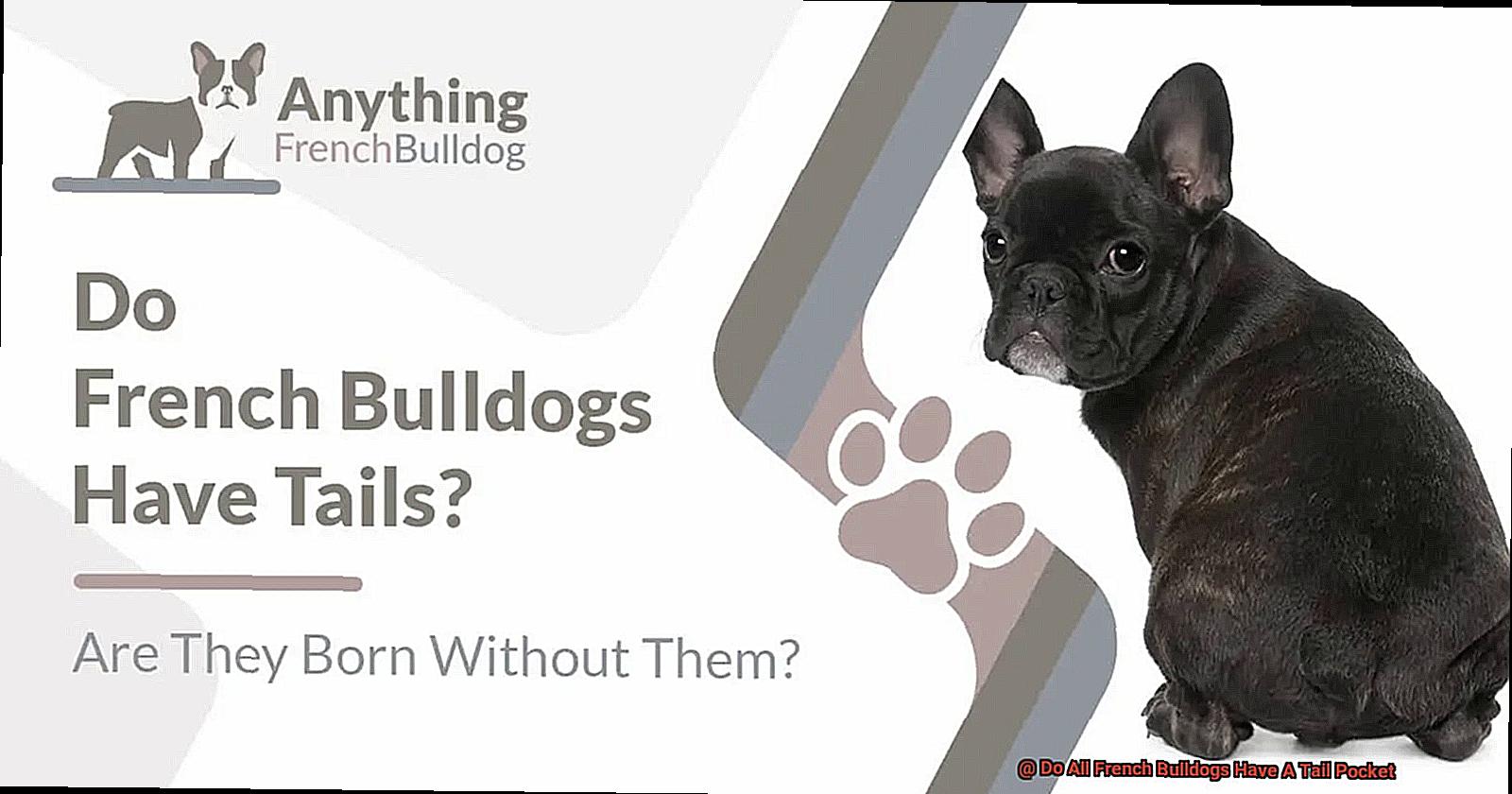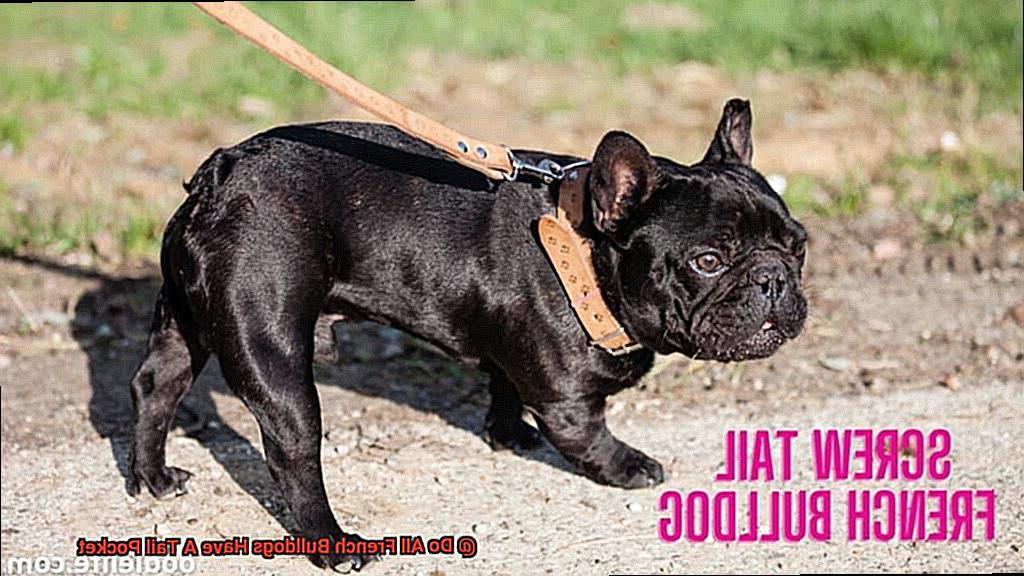Do All French Bulldogs Have A Tail Pocket?
Welcome to our blog post all about French bulldogs and their tail pockets. If you’re a fan of this adorable breed or considering adding one to your family, you may have heard whispers about the mysterious tail pocket. But what’s the deal? Do all French bulldogs have one? Don’t fret, we’ve got all the answers right here.
French bulldogs are renowned for their distinctive features, from their smushed faces to their pointy ears that could rival Batman’s. But there’s another secret characteristic that not everyone knows about: the tail pocket. A tail pocket, also known as a bum fold or fanny pouch (yes, we said it), is a tiny crevice nestled at the base of some French bulldog tails. While not every Frenchie boasts this hidden gem, it’s actually quite common in the breed.
In this blog post, we’re going to unravel the mystery behind why some French bulldogs sport a tail pocket while others don’t. We’ll take a deep dive into the anatomy of this intriguing little nook, discuss any potential health implications it may have, and dish out tips on how to properly care for and clean this unique feature. So whether you’re already proud parents of a Frenchie or just curious about their quirky traits, buckle up and get ready to explore the fascinating world of tail pockets in French bulldogs.
What is a Tail Pocket?
Contents
- 1 What is a Tail Pocket?
- 2 Genetics and Breeding of French Bulldog Tail Pockets
- 3 The Importance of Cleaning and Maintaining a French Bulldog’s Tail Pocket
- 4 Other Dog Breeds with Tail Pockets
- 5 How to Clean a French Bulldog’s Tail Pocket
- 5.1 Understanding the Tail Pocket:
- 5.2 – Why do some French Bulldogs have a tail pocket?
- 5.3 The Importance of Tail Pocket Hygiene:
- 5.4 – What can happen if the tail pocket is neglected?
- 5.5 Cleaning the Tail Pocket:
- 5.6 – Recommended cleaning materials and products
- 5.7 Drying and Preventing Moisture Build-up:
- 5.8 – Techniques for thoroughly drying the tail pocket
- 5.9 Regular Maintenance and Trimming:
- 5.10 – Tips for keeping the area around the tail pocket trimmed
- 5.11 Signs of Infection and When to Seek Veterinary Attention:
- 5.12 – When should you consult with your veterinarian?
- 6 When Veterinary Intervention is Necessary for a French Bulldog’s Tail Pocket
- 7 Signs of Infection in a French Bulldog’s Tail Pocket
- 8 How to Prevent Problems with a French Bulldog’s Tail Pocket
- 9 Conclusion
In this guide, we’ll dive into the world of French Bulldog tail pockets, exploring their anatomy, potential issues, and how to properly care for them. So, grab a cup of coffee and let’s get started.
What is a Tail Pocket?
A tail pocket is a small crease or fold of skin located at the base of the tail in certain dog breeds, including French Bulldogs. It’s essentially a little pocket that can trap moisture, dirt, and debris if not cleaned and maintained regularly. Think of it as a hidden nook that needs attention for your Frenchie’s comfort and health.
Why Do French Bulldogs Have Tail Pockets?
Tail pockets are believed to be remnants from the evolutionary past when dogs had longer tails. While other dog breeds may have less prominent tail pockets, French Bulldogs can have deeper ones due to their shorter, screw-shaped tails. This unique feature makes them more susceptible to issues if not properly cared for.
The Importance of Cleaning and Maintenance:
Proper cleaning and maintenance of the tail pocket are crucial for your French Bulldog’s overall well-being. If left unattended, the area can become a breeding ground for bacteria and yeast, leading to infections or unpleasant odors. Regular inspection and cleaning can help prevent these potential problems.
How to Clean a Tail Pocket:
Gather your supplies: mild soap or specialized pet wipes designed for tail pocket cleaning.
Gently lift your Frenchie’s tail to expose the pocket.
Using a cotton ball or soft wipes, gently clean the area with the soap or wipes.
Ensure that you thoroughly dry the area after cleaning to prevent moisture buildup.
Be cautious not to irritate or damage the sensitive skin in this area.
Tail Pocket Variations:
Not all French Bulldogs will have a visible or prominent tail pocket. The size and depth of the pocket can vary among individuals and may depend on factors such as genetics, age, weight, and overall health. Some French Bulldogs may have a small, shallow tail pocket that requires minimal attention, while others may have a deeper pocket that requires regular cleaning.
Professional Help:
If you’re unsure about how to properly clean your Frenchie’s tail pocket or if you notice any signs of infection, it’s always best to consult with a veterinarian or an experienced breeder. They can provide further guidance and recommend specific products or treatments tailored to your Frenchie’s needs.
Genetics and Breeding of French Bulldog Tail Pockets
Today, we’re going to explore the intriguing world of French Bulldog tail pockets and unravel the role that genetics and breeding practices play in determining whether or not our furry friends will have this unique feature.
Genetics and Tail Pocket Development:
Anatomy and Structure:
French Bulldogs have a distinctive tail structure, with a thick base that tapers towards the end. This structural characteristic is influenced by genetics and can contribute to the development of a tail pocket.
Brachycephalic Trait:
As brachycephalic breeds, French Bulldogs have a shortened skull and face. This characteristic can affect their overall anatomy, including the tail region, potentially increasing the likelihood of developing a tail pocket.
Breeding Practices and Tail Pocket Occurrence:
Selective Breeding:
Responsible breeders prioritize the health and well-being of their dogs. They selectively breed individuals without tail pockets to reduce the occurrence of this trait in future generations.
Desirable Hygiene Benefits:
Although some tail pocket presence may be considered desirable for hygiene purposes, excessive or deep pockets can cause discomfort and potential health issues. Responsible breeders aim for a balanced tail pocket that aids hygiene without causing discomfort.
Breeders’ Responsibilities:
Health Screenings and Examinations:
Responsible breeders conduct thorough health screenings and examinations on their breeding dogs, including checking for the presence of tail pockets. This ensures that only healthy individuals without severe pocket-related issues are used for breeding.
Genetic Testing:
To make informed breeding decisions, genetic testing can identify potential carriers of genes associated with tail pocket development. By avoiding breeding carriers together, breeders can reduce the chances of producing puppies with deep or problematic tail pockets.
Promoting Responsible Breeding:
Education and Awareness:
Breeders and owners must be knowledgeable about the genetics and breeding practices related to French Bulldog tail pockets. By sharing information and promoting awareness, we can encourage responsible breeding and minimize the occurrence of this trait.
The Importance of Cleaning and Maintaining a French Bulldog’s Tail Pocket
If you are the proud owner of a French Bulldog, you may have noticed a small, wrinkled area at the base of their tail. This is known as the tail pocket. Not all French Bulldogs have a tail pocket, but many do, especially those with shorter tails or screw tails. While this may seem like a cute little quirk, it is important to understand the significance of cleaning and maintaining this area for your Frenchie’s health and well-being.
Preventing Dirt and Bacteria Buildup
One of the main reasons why cleaning the tail pocket is crucial is to prevent the accumulation of dirt and bacteria. The tail pocket can easily collect debris, moisture, and even fecal matter. If left uncleaned, these substances can create an ideal environment for bacteria and yeast to thrive, leading to infections and skin irritations. Regular cleaning of the tail pocket helps keep it free from dirt and bacteria, reducing the risk of health issues.
Promoting Good Hygiene
Just like humans, dogs need good hygiene practices to maintain their overall health. Cleaning the tail pocket is an essential part of a French Bulldog’s hygiene routine. By regularly cleaning this area, you are ensuring that your Frenchie stays clean and comfortable. It also helps prevent any unpleasant odors that may arise from a dirty tail pocket.
Minimizing the Risk of Infections
Moisture trapped in the tail pocket can create a breeding ground for bacteria and yeast, which can lead to infections such as pyoderma or dermatitis. These infections can cause redness, swelling, itching, and discomfort for your Frenchie. By thoroughly cleaning and drying the tail pocket after each cleaning session, you are minimizing the risk of these infections and promoting a healthy environment for your furry friend.
Hair Trimming for Better Maintenance
In addition to regular cleaning, keeping the hair around the tail pocket trimmed short is also important for its maintenance. Long hair can easily get caught in the folds and crevices of the tail pocket, increasing the risk of matting and trapping moisture. By regularly trimming the hair around the area, you are reducing the chances of these issues and making cleaning easier.
Monitoring for Signs of Infections
While regular cleaning and maintenance can help prevent infections, it is important to keep a close eye on your French Bulldog’s tail pocket for any signs of redness, swelling, discharge, or irritation. These could be indications of an infection or other underlying health issues that require veterinary attention. By monitoring your Frenchie’s tail pocket regularly, you can catch any problems early on and seek appropriate treatment.
Other Dog Breeds with Tail Pockets
French bulldogs are not the only dog breed that may develop tail pockets. There are several other breeds that also have this unique feature. If you own a French bulldog and are interested in learning about other breeds with tail pockets, this section is for you.
English Bulldogs
English bulldogs are one of the breeds that often have tail pockets, just like their French counterparts. These dogs have a fold of skin at the base of their tail that forms a pocket. This pocket can collect moisture and debris, making it a breeding ground for bacteria and potential infections. Regular cleaning and maintenance are crucial to keep the tail pocket clean and healthy.
Boston Terriers
Another breed with a tail pocket is the Boston terrier. These small but sturdy dogs also have a natural pocket that can trap dirt and bacteria. It is important to regularly clean the tail pocket to prevent any infections or discomfort for your furry friend.
American Bulldogs
American Bulldogs, known for their strength and athleticism, are also prone to having tail pockets. Owners of American Bulldogs should pay close attention to their dog’s tail pocket hygiene to prevent any health issues.
Other Breeds
While not as common as in French bulldogs, some other breeds may also have tail pockets. These include Boxers, Staffordshire Bull Terriers, and Pugs. Not all individuals of these breeds may have tail pockets, but it is important for owners to be aware of this possibility and take appropriate measures to keep the area clean and healthy if a tail pocket is present.
Caring for Dogs with Tail Pockets
Caring for dogs with tail pockets requires regular cleaning and maintenance. Here are some tips to help you properly care for your dog’s tail pocket:
- Clean the area regularly: Use a gentle dog-safe cleanser or wipes to clean the tail pocket at least once a week, or more frequently if necessary. Make sure to remove any debris or buildup.
- Dry the area thoroughly: After cleaning, pat the tail pocket dry with a clean towel to remove any moisture. A damp environment can lead to bacterial growth and infections.
- Monitor for signs of infection: Keep an eye out for redness, swelling, discharge, or foul odor in the tail pocket. These can be signs of an infection and should be addressed by a veterinarian.
- Trim excess hair: If your dog has long hair around the tail pocket, consider trimming it to minimize the risk of debris getting trapped and causing issues.
- Regular veterinary check-ups: Schedule regular check-ups with your veterinarian to ensure your dog’s overall health and well-being. They can provide guidance specific to your dog’s breed and individual needs.
Remember, each dog is unique, and tail pockets may vary in size and depth among breeds. It is important to consult with your veterinarian for personalized advice on how to care for your dog’s tail pocket properly.
How to Clean a French Bulldog’s Tail Pocket
This is called a tail pocket, and it requires special attention to keep it clean and healthy. In this guide, we’ll explore the importance of maintaining your French Bulldog’s tail pocket hygiene and provide step-by-step instructions on how to clean it properly.
Understanding the Tail Pocket:
– Why do some French Bulldogs have a tail pocket?
The Importance of Tail Pocket Hygiene:
– What can happen if the tail pocket is neglected?
Cleaning the Tail Pocket:
– Recommended cleaning materials and products
Drying and Preventing Moisture Build-up:
– Techniques for thoroughly drying the tail pocket
Regular Maintenance and Trimming:
– Tips for keeping the area around the tail pocket trimmed
Signs of Infection and When to Seek Veterinary Attention:
– When should you consult with your veterinarian?
When Veterinary Intervention is Necessary for a French Bulldog’s Tail Pocket
The French Bulldog – a breed known for its adorable bat-like ears and snorting sounds that can make anyone giggle. But did you know that these lovable pups also have a little secret tucked away? That’s right, we’re talking about their tail pockets. Now, before you start scratching your head in confusion, let me explain what exactly a tail pocket is and why veterinary intervention may be necessary for it.

What’s the Deal with Tail Pockets?

A tail pocket is a deep crevice that forms between the base of a French Bulldog’s tail and their body. It’s like a secret hiding spot where bacteria, yeast, and other microorganisms can throw a party if not properly cleaned and maintained. Due to the unique body shape and structure of French Bulldogs, some of them are more prone to developing tail pockets than others. So, if you’re a proud parent of a Frenchie, it’s important to keep an eye on this hidden area.
When Should You Call in the Experts?
While regular cleaning and maintenance can help prevent most issues with tail pockets, there are times when veterinary intervention becomes necessary. Here are some situations where you should definitely pick up the phone and give your vet a call:
- Infections Galore: If your Frenchie’s tail pocket becomes infected, it may require antibiotics or other medications to kick those pesky bacteria out. Keep an eye out for redness, swelling, discharge, and that unmistakable foul odor – these are all signs of an infection that needs professional attention.
- Pus Party: In some cases, pockets of pus can form within the tail pocket, resulting in abscesses. Ouch. These painful pockets will need to be drained by a veterinarian and treated with antibiotics to ensure proper healing.
- Dealing with Inflammation: When the tail pocket becomes inflamed or irritated, it can cause discomfort for your furry friend. In these cases, a vet may recommend topical treatments or anti-inflammatory medications to reduce inflammation and provide some much-needed relief.
- Chronic Troubles: Some French Bulldogs have chronic problems with their tail pockets, experiencing recurrent infections or inflammation. In these cases, veterinary intervention may involve more extensive treatments or even surgical options to resolve the issue once and for all.
Remember, Prevention is Key.
While veterinary intervention can be necessary at times, prevention is always better than cure. Regularly checking and cleaning your French Bulldog’s tail pocket can help prevent most problems from arising. Use a gentle cleanser recommended by your vet and make sure to dry the area thoroughly after cleaning to discourage the growth of bacteria and yeast.
Signs of Infection in a French Bulldog’s Tail Pocket
French Bulldogs are adorable and lovable companions, but like any breed, they can experience health issues. One area that requires special attention is their tail pocket. This deep fold of skin, located at the base of their tail, needs regular cleaning and inspection to prevent infections. In this article, we will discuss the signs of an infected tail pocket and how to address them promptly to ensure your furry friend stays healthy and happy.
Redness and Swelling:
One of the first signs of an infected tail pocket is redness and swelling. If you notice these symptoms when examining your French Bulldog’s tail pocket, it may indicate an infection. The redness can range from mild to severe, depending on the extent of the infection.
Discharge and Foul Odor:
Another telltale sign of an infected tail pocket is the presence of discharge. This discharge can be thick, yellowish, or pus-like in consistency. Additionally, a foul odor may accompany the discharge, which is a clear indicator that something is not right.
Pain or Tenderness:
Infected tail pockets can cause discomfort for your French Bulldog. If you observe your furry friend showing signs of pain or tenderness when you touch or examine their tail pocket area, it’s essential to take action promptly.
Spreading Infection:
In severe cases, the infection in a French Bulldog’s tail pocket can spread to the surrounding skin and even to other parts of the body. This can lead to more serious health issues and complications if left untreated. Therefore, it’s crucial to monitor the infection closely and seek veterinary attention as soon as possible.
What to Do if You Suspect an Infection:
If you notice any signs of infection in your French Bulldog’s tail pocket, it is vital to seek veterinary attention promptly. A veterinarian will examine the tail pocket, assess the severity of the infection, and prescribe appropriate treatment. This may include antibiotics, topical medications, or other recommended treatments.
Prevention is Key:
Regular cleaning and maintenance of your French Bulldog’s tail pocket can help prevent infections from occurring in the first place. Gently clean the area with a pet-friendly cleanser recommended by your veterinarian. Be sure to dry the tail pocket thoroughly after cleaning, as moisture can contribute to bacterial growth.
How to Prevent Problems with a French Bulldog’s Tail Pocket
While not all French Bulldogs have this feature, it’s important to understand how to prevent problems with their tail pocket if yours does. In this article, we’ll provide you with helpful tips and advice to keep your furry friend’s tail pocket clean and healthy.
Regular Cleaning is Key:
To prevent bacteria and yeast from causing infections, it’s crucial to clean your French Bulldog’s tail pocket regularly. Use a mild, dog-friendly cleanser and warm water to gently wipe the area at least once a week. Be thorough but gentle, making sure to remove any dirt or debris that may have accumulated.
Keep it Dry:
Moisture can create a breeding ground for bacteria, so it’s essential to keep your French Bulldog’s tail pocket dry. After cleaning, pat the area with a clean towel or use a low, cool setting on a hairdryer to ensure it’s completely dry.
Trim Excess Hair:
Long hair around the tail area can trap dirt and moisture in the tail pocket, increasing the risk of infection. Regularly trim any excess hair around the area to minimize these risks. Remember to be cautious and use grooming tools specifically designed for dogs.
Maintain Overall Hygiene:
Regular bathing, nail trimming, ear cleaning, and teeth brushing are essential for your French Bulldog’s overall hygiene. Keeping them clean and free from excessive dirt and bacteria can reduce the chances of problems in the tail pocket.
Monitor for Signs of Infection:
Pay close attention to your French Bulldog’s tail pocket for any signs of infection or irritation. If you notice redness, swelling, foul odor, discharge, or excessive licking or itching, it’s crucial to consult a veterinarian for proper diagnosis and treatment.
zFI6f_Kx8Ac” >
Conclusion
In conclusion, it is not accurate to say that all French bulldogs have a tail pocket.
While many Frenchies do have a tail pocket, it is not a universal trait among the breed. Some French bulldogs may have a more pronounced tail pocket, while others may have a less noticeable one or none at all.
Regular cleaning and maintenance can help keep the tail pocket clean and free from infections or irritations.




